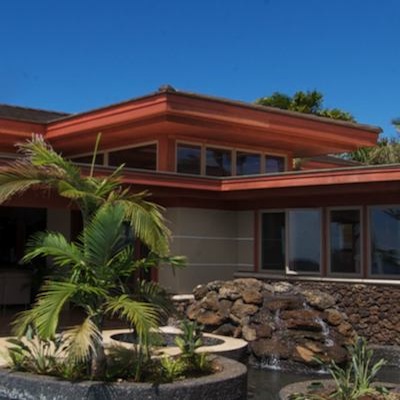Passive Solar Cooling - Roof Overhangs

In a passive solar home design, one of the simplest and most practical methods of cooling a home is through the use of roof overhangs to shade windows, doors, and walls.
The theory is simple; in the winter months the sun is at a much lower angle in the sky, allowing its rays (and heat) into a house through the windows and walls, helping to heat the building.
During the warmer months, the sun's angle is much higher in the sky, and a roof overhang keeps the sun's energy from entering the house, reducing the need for air conditioning.
Overhangs are most effective on south-facing sides of homes, where they shade the midday sun. But you will find that there additionally are some benefits to skillfully designing overhangs for eastern and western exposures, but truthfully for summer cooling effects, it works much better to try to limit the sun exposure on exposed glass on these exposures with deciduous plantings, solar light shelves and many other ingenuous devices that are currently available.
Deciduous plantings will allow the warming rays of the sun to naturally heat the home during the late fall, winter and early spring months.
Types of Roof Overhangs
Typical Roof Overhangs: A solid, fixed roof overhang is typically the extension of the roof out away from the house, and they may be solid or louvered. These fixed roof overhangs offer longevity and low maintenance, but are not able to be adjusted to site-specific or seasonal factors. If the roof is too distant above the windows to be an effective shading device, may designers will design smaller "eyebrows", which are window specific sun protection devices.
Lightshelves: Also, an option that has been gaining traction in the design community are the "solar light shelves", which are integral with the windows and efficiently provide shading exactly where it is needed. They are also available with a reflective component, which allows directly to bounce off the surface of the shelf, through upper glass and into the ceiling of the space.
Shutters & Awnings: Adjustable and/or removable roof overhangs include such things as shutters and awnings, which allow the home owner to fine tune the amount of shade or sunlight over a particular window or door. These types of overhang products offer much more flexibility but do often require more maintenance.
Sizing a Roof Overhang
The size and type of roof overhang you choose for your green home's design depends largely on where your home is going to be built. Due to varying climate conditions around the U.S., it is difficult to address specific needs here. Your green home designer will work closely with you to ensure that your green home has the proper size and type of roof overhangs to maximize energy savings
Once your geographical location is established, and the home has been correctly sited on the property, the sun angles can be projected for both winter and summer and the optimal overhangs can be designed.
comments powered by Disqus

























































































































































































